By Jill Delaney
Library and Archives Canada (LAC) is pleased to announce a major acquisition of Gabor Szilasi’s photographs, representing his lifetime of work (1954–2016), including approximately 80,000 negatives and forty-one prints. This acquisition will make it possible to preserve his legacy and to provide access for Canadians and international researchers to the breadth and depth of this extraordinary photographer’s career and vision. The Gabor Szilasi fonds now includes early images from Hungary, the negatives from all his personal Canadian projects, and the photographs taken on visits back to Hungary and travels to other countries, including Italy, Poland, France and the United States.
Gabor Szilasi was born in Budapest, Hungary, in 1928. His mother was a violinist with the Symphony of Budapest, and he grew up in a home and a society interested in music, art and culture (Gabor himself was a clarinetist in an amateur orchestra in Montréal for several years). Tragically, his mother died in a concentration camp, and his two siblings died of illness during the Second World War.
Hungary has a reputation for producing great photographers, including André Kertesz, Brassaï, Lászlō Moholy-Nagy and Robert Capa. However, the path to becoming a photographer was not straightforward for Szilasi. He enrolled in medical school in 1948, but tried to flee the new communist regime in 1949. He was imprisoned for five months, and barred from further university study and professional work. While he found manual labour and piece work after his release, Szilasi spent many hours at the Alliance Française (an international network of French language and cultural centres), which gave him access to a library featuring many books on photography. He bought his first camera in 1952 and began to shoot photographs around the city and while on holiday, as well as photographs of his family and friends. These early images show the influence of those Hungarian photographers, but also that of the Italian neo-realist cinema that he loved, and demonstrate his interest in photographing ‘ordinary’ people.
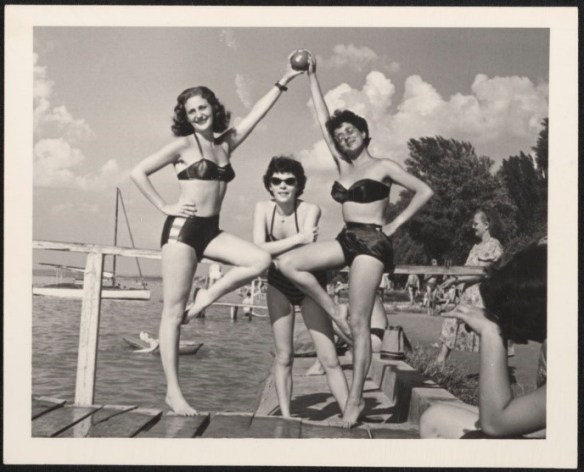
At Lake Balaton, Hungary. c. 1954–1956. Photo: Gabor Szilasi (e011435661)
Szilasi’s second attempt to flee Hungary came shortly after the Hungarian Uprising of 1956. The LAC fonds includes the negatives for the photographs he shot in Budapest during those chaotic days, including photographs taken when the Soviet military moved in to quell the protests. He fled to Austria days later. His father followed shortly after, smuggling the negatives out in the diaper of a friend’s baby.

Crowd on top of Stalin monument October 28, 1956 – Hungarian Revolution. Photo: Gabor Szilasi (e011313448)
Upon Gabor Szilasi and his father landing as refugees in Halifax in 1957, Gabor was sent directly to a sanatorium for treatment of tuberculosis. During the next year, he spent his time in convalescence learning French and English, and poring over photographs and photo stories in magazines such as Life, Paris Match and Saturday Night. His father, Sandor Szilasi, found work in forestry. Once in good health, Gabor also found work and began to take photographs again, meeting various Quebec photographers, who encouraged his interest. In August 1958, he won his first Canadian award, the 20th Annual Newspaper National Snapshot Award for a photograph he had taken in Budapest.
By January 1959, Szilasi had found his first job in photography, working as a darkroom technician in the Service de Ciné-photographie du Québec, in Montréal (which later became the Office du film du Québec (OFQ)). He was quickly promoted to photographer, and his assignments led to extensive travel within the province.
He also continued with his study of the work of other photographers, creating an impressive personal library on the subject. During this period, he was influenced by photographers such as Paul Strand and Walker Evans, whose works portraying ‘everyday people’ were key in the development of the social documentary form of the mid-20th century. In his travels for the OFQ, and under the influence of these photographers, Szilasi found himself drawn to the vernacular of the province, the people and places of rural Quebec, a culture and a way of life unfamiliar to his urbane upbringing in Budapest.
In the early 1970s, he took on his first job as a photography instructor, at the Cégep du Vieux Montréal (1971–1979). He later taught at Concordia University (1980–1995). During this time, Szilasi began to work on his own in these regions, creating a series of remarkable portraits and views that would earn him national and international recognition. Armed with his 4×5 camera and tripod, his curiosity (he has referred to himself as ‘nosy’), and his affability and gentle charm, he gained entry into the homes and businesses of the local inhabitants, in communities such as Île aux Coudres, Charlevoix and Lotbinière. This work caught the attention of the Canadian photography community and the archivists at the Public Archives of Canada (which later became Library and Archives Canada). The Public Archives of Canada acquired a selection of 51 of these prints, in 1975 and 1982.
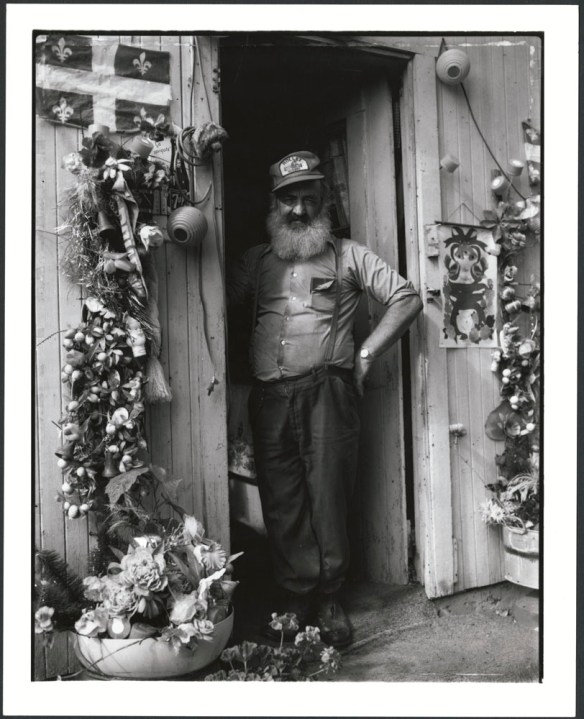
Louis-Philippe Yergeau. 1977. Photo: Gabor Szilasi (e011435658)
The portraits are carefully composed and perceptive environmental portraits of people he met over the course of several years. The elements that surround his subjects act as a kind of vernacular iconography, narrating their lives and illuminating their place in the cultural and social life of rural Quebec as it was undergoing rapid change. Later photography trips in the 1970s focussed on documenting the places themselves, such as Abitibi-Témiskamingue and Rouyn-Noranda, revealing Szilasi’s other abiding interest: architectural photography.
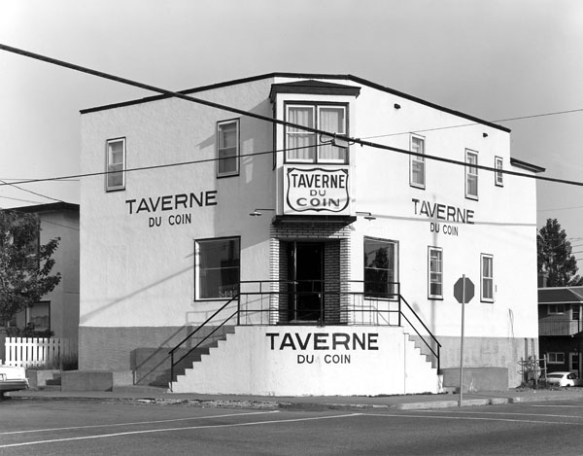
Taverne du Coin. Rouyn, Quebec. 1979. Photo: Gabor Szilasi (e010692454)
These two themes—portraiture and architecture—have dominated his long and prolific career. LAC acquired a selection of his Sainte-Catherine Street storefront photographs in 1983, a project he began in 1979. The views, taken along the length of the street, allow the viewer to consider the history of the buildings and of the street, from the original facades of the 19th and early 20th centuries through the subsequent layering of new signage, new siding, or other embellishments and renovations. Szilasi’s recognition of the constant change that pervades and shapes our modern culture has driven much of his work.
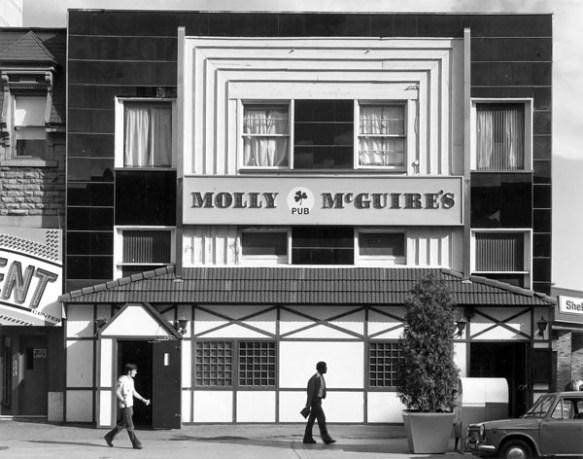
Molly McGuire’s Pub, 2204 Ste. Catherine Street West, Montreal. 1977. Photo: Gabor Szilasi (e010692455)
The Szilasi fonds includes prints and negatives from two other architectural projects. In his Intersections project, the photographer expands, literally, on his storefront images of Montréal by creating expansive views of characteristic intersections in the city. Using a banquet camera to widen the view, he makes the buildings appear as isolated islands surrounded by pavement and automobile traffic, thus creating a sombre reflection on the North American city.
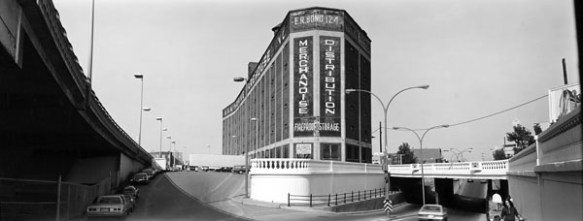
Angle St. Laurent and Van Horne. Montréal, 1981. Photo: Gabor Szilasi (e010692453)
In Gabor’s LUX project, the photographs focus on the quality of light as much as the architecture, while documenting the visual language and motifs of consumer culture. Szilasi ventured out into the summer dusk with his camera to capture the unique neon signs of Montréal’s retail businesses at just that magical moment between day and night, when the sky seems to glow with the same intensity as the neon signs, infusing the images with a sense of delight and intimacy.
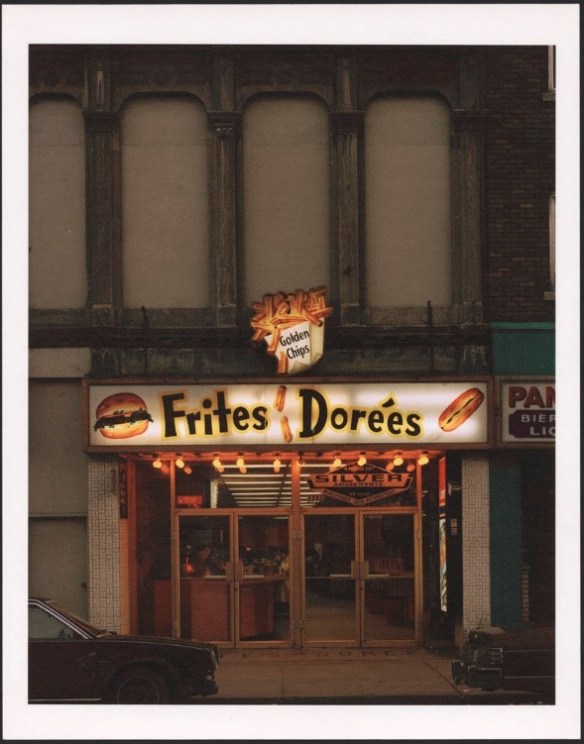
LUX: Frites Dorées. Montréal. c. 1982–1985. Photo: Gabor Szilasi (e011435666)
The fonds also reveals the multifaceted and evolving nature of Szilasi’s portraiture over time. The photographer has played with many different approaches and cameras throughout his career to explore the notion of portraiture itself. The negatives include his early street photography in Budapest, the rural environmental portraits, his portrait diptychs of the late 1970s, the closely cropped collaborative portraits shot with a Polaroid 55 camera starting in 1992, and his self-portraiture project with the clients of Les Impatients in Montréal in 2003–2004.
In between all of these important projects, Szilasi was also constantly documenting the arts scene, the artists and writers of Montréal, as well as various Montrealers, through works such as his unforgettable portrait of a car salesman at the Auto Show in 1973. He has also recorded the diversity of his adopted city, from his street photography of his fellow citizens during Saint-Jean-Baptiste celebrations in 1970, to a documentation project on the citizens of the immigrant-rich Saint-Michel neighbourhood starting in 1996.

Ford/Mercury salesman at Salon d’automobile, Place Bonaventure, Montréal, Quebec. 1973. Photo: Gabor Szilasi (e011435663)
These negatives showcase Szilasi’s deep involvement with both the photographic and artistic communities in Montréal. Like most photographers, he carried his camera with him almost all the time. This resulted in a loose, but extensive, body of work documenting his friends as well as many other photographers, artists, writers, and musicians. His photographs of the innumerable vernissages he attended beginning in 1960 were the subject of a major exhibition (Gabor Szilasi: The Art World in Montréal, 1960–1980) held in 2017 at the McCord Museum, in Montréal. Other lesser known images in the collection come from his many commissions, including for Cirque du Soleil, the Canadian Centre for Architecture, the Montréal Museum of Fine Arts (photographs taken in Giverny, France), as well as from his various trips back to Budapest and his travels to other locales during his long career.
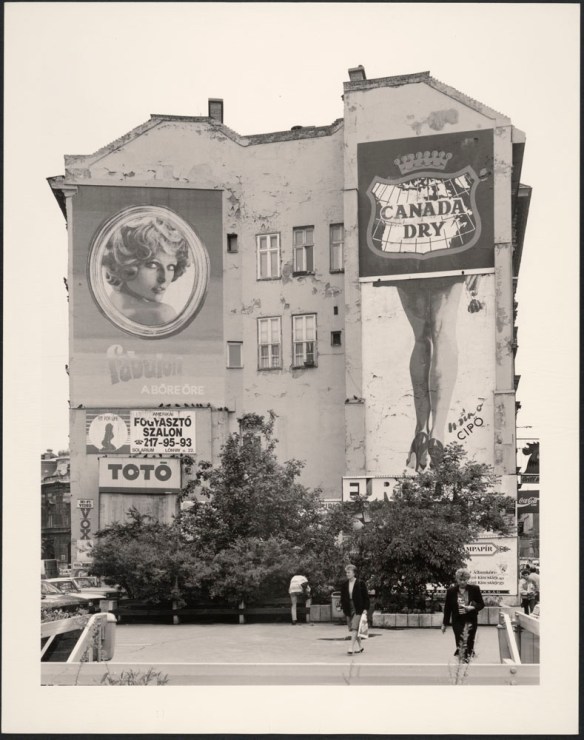
Budapest (Canada Dry). Budapest, Hungary, 1995. Photo: Gabor Szilasi (e011435665)

Sam Tata in his apartment in Ville Saint-Laurent, Montréal, Quebec. June 1988. Photo: Gabor Szilasi (e011435660)

Photographer Gabor Szilasi photographing in Sam Tata’s apartment]. Ville Saint-Laurent, 1979. Photo: Sam Tata (e010977793)
Lastly, LAC has also acquired a number of prints of Szilasi’s self-portraits in the most recent accrual. These photographs vary from an early casual image clicked with the camera held at arms length, to an enigmatic portrait taken in the heat of a Cocoa Beach, Florida, motel room, with his wife and daughter in a doorway behind him, and a more recent photograph (2014) of himself in a mirror surrounded by hundreds of his beloved photography books.
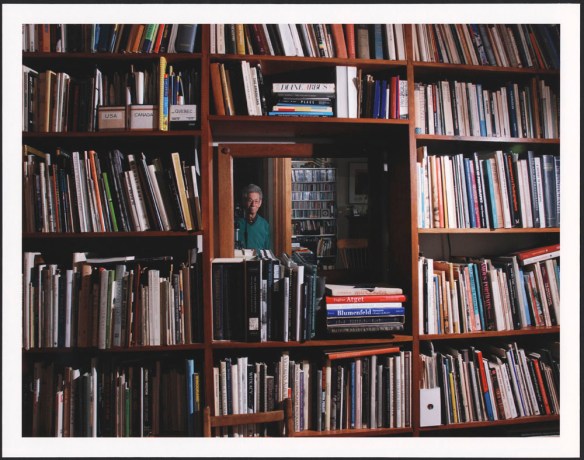
Self-portrait, Westmount, Quebec. 2014. Photo: Gabor Szilasi (e011435667)
These images are further evidence of Szilasi’s commitment to experimentation with the medium to which he was first exposed in the library of the Alliance Française in Budapest. The negatives and prints in the LAC fonds provide a wealth of images exploring the people and places that became his home and his community in Montréal and Quebec.
Other LAC resources:
Jill Delaney is a Lead Archivist, Photography, in the Specialized Media Section of the Private Archives Division at Library and Archives Canada.
